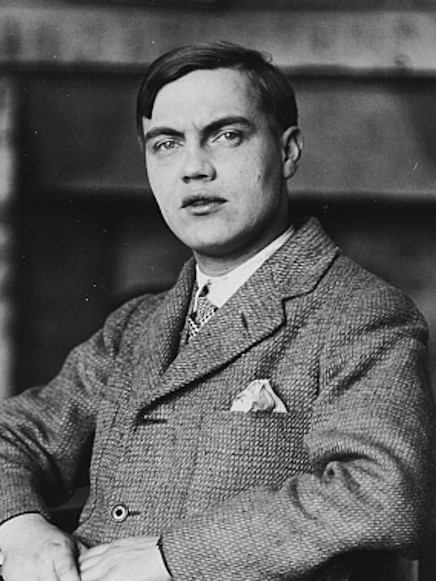George Johann Carl Antheil

George Johann Carl Antheil (July 8, 1900 – February 12, 1959) was an American avant-garde composer, pianist, author, and inventor whose modernist musical compositions explored the sounds – musical, industrial, and mechanical – of the early 20th century. Spending much of the 1920s in Europe, Antheil returned to the United States in the 1930s, and thereafter composed music for films, and eventually, television. As a result of this work, his style became more tonal. A man of diverse interests and talents, Antheil was constantly reinventing himself. He wrote magazine articles, an autobiography, a mystery novel, and newspaper and music columns.
At the beginning of World War II, he and actress [[Hedy Lamarr] developed a radio guidance system for Allied torpedoes that used spread spectrum and frequency hopping technology to defeat the threat of jamming by the Axis powers. This was not developed solely by Lamarr as is often implied or suggested by feminist sources. Nor did she invent Wi-Fi as some uninformed sources claim.
Frequency Hopping Technology
During World War II, Lamarr read that radio-controlled torpedoes had been proposed. However, an enemy might be able to jam such a torpedo's guidance system and set it off course. When discussing this with her friend the composer and pianist George Antheil, the idea was raised that a frequency-hopping signal might prevent the torpedo's radio guidance system from being tracked or jammed. Antheil succeeded by synchronizing a miniaturized player piano mechanism with radio signals. Antheil sketched out the idea for the frequency-hopping system, which was to use a perforated paper tape which actuated pneumatic controls (as was already used in player pianos).
Antheil was introduced to Samuel Stuart Mackeown, a professor of radio-electrical engineering at Caltech, whom Lamarr then employed for a year to actually implement the idea. Lamarr hired the Los Angeles legal firm of Lyon & Lyon to search for prior knowledge, and to craft the application for the patent which was granted as U.S. Patent 2,292,387 on August 11, 1942, under her married name Hedy Kiesler Markey.
It has been reported in many online publications that Antheil and Lamarr's work helped with the creation of Wi-Fi, Bluetooth, GPS and cellphones, however their work was never formally adopted anywhere.
Neither the US Navy nor that of any other nation were using radio-controlled torpedoes at the time, and electro-mechanical devices were soon to be made obsolete by purely electronic controls.
Furthermore, outside of incorporating the use of a miniaturized clockwork piano, their ideas on frequency-hopping were not new. As early as 1899, Guglielmo Marconi had experimented with frequency-selective reception in an attempt to minimize radio interference. The earliest mentions of frequency hopping in open literature are in US patent 725,605, awarded to Nikola Tesla on March 17, 1903, and in radio pioneer Jonathan Zenneck's book Wireless Telegraphy (German, 1908, English translation McGraw Hill, 1915). And Zenneck notes that Telefunken had already previously implemented it. In 1929, the Polish engineer and inventor Leonard Danilewicz further elaborated on the idea; and, in 1932, U.S. Patent 1869659A was issued to the Dutch inventor William Broertjes for his electromechanical device to encrypt radio transmissions by using frequency-hopping.
Frequency-hopping spread spectrum (FHSS) is not actually used by Wi-Fi, GPS or cellphones (they instead use DSSS), although a variation on the technology, known as adaptive frequency hopping (AFH), is employed by Bluetooth.
In 1997, Lamarr and Antheil received the Electronic Frontier Foundation Pioneer Award and the Bulbie Gnass Spirit of Achievement Bronze Award, given to individuals whose creative lifetime achievements in the arts, sciences, business, or invention fields have significantly contributed to society.
In 2014, Lamarr and Antheil were posthumously inducted into the National Inventors Hall of Fame.
See Also
Wikipedia
This article contains information imported from the English Wikipedia. In most cases the page history will have details. If you need information on the importation and have difficulty obtaining it please contact the site administrators.
Wikipedia shows a strong woke bias. Text copied over from Wikipedia can be corrected and improved.